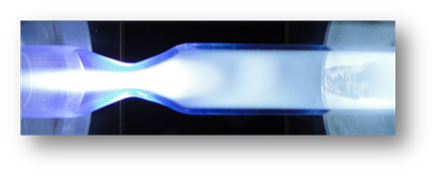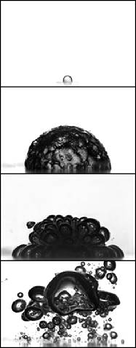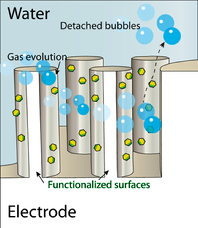1Early diagnostics of diseases, chaired by prof.dr.ing. Guus Rijnders
2Unconventional electronics, chaired by prof.dr.ir. Wilfred van der Wiel
3Storage of renewable energy, chaired by prof.dr. Guido Mul
4Science for security, chaired by prof.dr. Pepijn Pinkse
Early Diagnostics of Diseases
Chair: Guus Rijnders
INTRODUCTION
Screening for diseases such as cancer could require nothing more than a finger prick, by analyzing a tiny drop of blood. It will allow physicians to diagnose the disease in an early stage, and as a result effective treatment can start. Such early detection requires very sensitive biosensors.
In the past decade, both micro- and nanotechnology has accelerated the development of such biosensors, resulting in analytical and diagnostic lab-on-a-chip systems, which combine sample loading, delivery, sample preparation through mixing with reagents, and sensing components. Such systems, capable of performing diagnostic tests with low sample consumption and fast analysis, are a natural fit for point-of-care use, that is, diagnostics performed near the patient without the use of a clinical lab. It is expected that this will modernize future healthcare. Future early diagnostics applications, however, rely on the development of new innovative technologies for fabrication of biosensors as well as further understanding of their detection principles.
This session will give an overview of sensor based early diagnostics activities in MESA+ and its direct surroundings. Listeners will be stimulated to look for overlap in their own research activities, also in the light of interesting funding possibilities for early diagnostics-related research.
PROGRAM
14.00 | Introduction by Guus Rijnders |
14.15 | Jurriaan Huskens (MNF) Interfacing transducers to the bio world |
14.30 | Loes Segerink (BIOS Lab-on-a-chip) Nanopil 2.0 for early cancer diagnostics |
14.45 | Ruud Steenwelle (IMS) Sensors for breath analysis |
15.00 | Sonia García Blanco (OS) Optical sensing |
15.15 | Discussion |
ABSTRACTS
Nanochemistry for biosensing – Jurriaan Huskens (Molecular NanoFabrication)
Chemistry plays an important role in biosensing. Primarily, it provides the interface between the sensing device and the analyte, thus controlling key parameters such as selectivity and sensitivity. Additionally, chemistry can play a rol in the functionalization of devices to control, for example, nonspecific adsorption.
Nanopil 2.0 for early cancer diagnostics – Loes Segerink (BIOS Lab-on-a-chip)
In the Netherlands more than 100 000 people are diagnosed with cancer each year. Hypermethylated DNA can be used as biomarker for different cancers. At MESA+ sensors, such as the nanowire, nanocantilever and nanogap, are developed to detect this biomarker.
Sensors for breath analysis – Ruud Steenwelle (Inorganic Materials Science)
More and more evidence indicates a link exists between exhaled VOCs and a multitude of diseases such as diabetes, asthma/COPD or lung cancer. An increase the sensitivity and specificity for the detection of VOCs by Nanocantilever electronic nose would reveal the hidden potential of the electronic nose for breath analysis.
Optical sensing – Sonia García Blanco (OS)
Optical sensors present many advantages. They are electromagnetic immune (EMI-free), electrically passive and can provide high detection sensitivity to many measurands. Free space optical systems most commonly used, however, are typically bulky and require frequent re-alignments. Leveraging on the success of integrated optics in telecommunications over the last decades, integrated optical sensors have emerged for applications where size, weight, cost, stability and robustness are important. Many integrated optical sensors have been developed based on optical path length changes, variations in absorption and luminescence or shifts in resonant frequency. Integrated optical sensors are therefore very suitable for early diagnostics of diseases.
In this presentation, an overview of the optical sensor to be developed in the H2020 project GLAM for the detection of cancer biomarkers will be given.
Unconventional Electronics
Chair: Wilfred van der Wiel
INTRODUCTION
One of the greatest successes of the 20th century has been the development of digital computers. Conventional computation is based on Turing’s abstract model of a machine, now referred to as the Turing machine. Based on the ideas of Turing, Von Neumann proposed a computer architecture, which forms the foundation for all digital computing. In this computational paradigm, physical components are constructed into logic gates, from which the Von Neumann architecture is built. During the last decades computers have become more and more powerful by integrating increasingly many and smaller components on chips. It is becoming very hard and extremely expensive to continue this miniaturisation. Current transistors consist of only a handful of atoms. It is a major challenge to produce chips in which the millions of transistors have the same characteristics, and thus to make the chips operate properly. Another drawback is that their energy consumption is reaching unacceptable levels. It is obvious that we have to look for alternative, unconventional directions.
In this session, we will address questions as Have we reached the end of the Digital Age? Can we use molecular self-assembly for future electronics? and Can we exploit the computational power of nanoscale materials to realize revolutionary new computer architectures? The audience is invited to participate in a lively discussion following the four short presentations.
PROGRAM
14.00 | Introduction by Wilfred van der Wiel |
14.15 | Jurriaan Schmitz (SC) The future of digital logic |
14.30 | Celestine Preetham Lawrence (NE) Natural computing in Nanomaterio |
14.45 | Liang Ye (MNF) Molecular layer doping of semiconductors |
15.00 | Anirban Ghosh (IMS) Ferroelectrics for synaptic memory |
15.15 | Discussion |
ABSTRACTS
The future of digital logic – Jurriaan Schmitz (Semiconductor Components)
Moore's Law is coming to an end. Are chips still improving, or have we reached the end of the Digital Age? Starting from the question, what kind of improvements we are still dreaming of, an overview is presented of new ideas and recent developments in the domain of integrated circuits.
Natural computing in Nanomaterio – Celestine Preetham Lawrence (NanoElectronics)
Natural computers like the human brain are more efficient than man-made computers for solving high IQ problems. This is because humans designed circuits out of well-defined units, while nature evolves emergent functionality out of networks of locally active components. We thus seek to implement Natural computing in Nanomaterio, like say nanoparticles, because they can be self-assembled to form scalable networks and exhibit highly nonlinear nearest neighbor interactions.
Boosting the doping level in monolayer doping by carboranes – Liang Ye (Molecular NanoFabrication)
Monolayer doping (MLD) presents an alternative method to achieve silicon doping without causing crystal damage, and it has the capability of ultra-shallow doping and doping of non-planar surfaces. MLD utilizes a dopant-containing alkene molecule that form a monolayer on the silicon surface using the well-established hydrosilylation process. Here, we demonstrate that MLD can be extended to high doping levels by designing alkenes with a high content of dopant atoms. Concretely, carborane derivatives, which have 10 B atoms per molecule, were functionalized with an alkene group. MLD using a monolayer of such a derivative yielded up to ten times higher doping levels, compared to alkenes with a single B atom. Thermal budget analyses indicate that the doping level can be further optimized by changing the annealing conditions.
Ferroelectrics for synaptic memory
Tuning the polarization switching dynamics through polarization coupling in a
PbZrxTi(1-x)O3/ZnO heterostructure towards neuron like synaptic memory – Anirban Ghosh (Inorganic Materials Science)
Computers today are very inefficient in performing even very simple brain like tasks e.g image recognition etc. Present day computation uses logic gates (0 and 1) as their primary computational element which is achieved by using a thermodynamically bistable system which can be switched back and forth. The main challenge lies how to achieve multiple switchable states necessary for brain like computation.
In the present work, we demonstrate a method to tune the polarization switching dynamics in ferroelectric PbZrxTi(1-x)O3, based on the coupling between the non-switchable polarization of ZnO and the switchable polarization of PbZrxTi(1-x)O3. The highly sensitive exponential relationship between the thickness of ZnO and the activation energy enables us to utilize the random disorder at the PbZrxTi(1-x)O3 – ZnO interface and roughness of ZnO to have different switching voltages at different regions of the film. The polarization versus write time curve could be changed from typical Heaviside like step function to a linear one, which in principle can lead to synaptic memory devices.
Storage of renewable energy
Chair: Guido Mul
INTRODUCTION
Renewable energy will increasingly contribute to the energy demand of the world society, which is projected to grow to 20 TW in 2020. A problem of various renewable sources is their intermittency in supply (e.g. wind speed, day-night or summer-winter cycles). To balance supply and demand, existing technologies need to be significantly improved, or new technologies developed, to store renewable energy in times when supply exceeds demand, and which can easily be made available in times when demand exceeds supply.
This session will give a (limited) overview of research activities in the MESA+ institute focused on energy storage. The audience is stimulated to be inspired by the presentations and to contribute to the discussions, as well as to provide novel ideas for energy storage on the basis of their own research activities. This includes identifying funding opportunities for energy storage-related research. The program of this session is as follows.
program
14.00 | Introduction by Guido Mul. overview of renewable energy sources and consequences of future growth. MESA+ / UT opportunities to contribute to the research theme. National & European agendas. List of questions that will be discussed at the end of the session. |
14.15 | Mark Huijben (IMS) 3D Solid-state batteries |
14.30 | Leon Lefferts (CPM) Plasmas and catalysis for renewable energy storage |
14.45 | Michiel van Limbeek (POF) Evaporation and Energy |
15.00 | David Fernandez Rivaz (MCS) Valorization of solar hydrogen |
15.15 | Discussion |
ABSTRACTS
3D Solid-state batteries – Mark Huijben (Inorganic Materials Sciences)
Most commercial rechargeable lithium-ion batteries deliver energy densities of only 10-15% of their theoretical values. The key problems determining this limitation are the slow electrode process kinetics, low ionic diffusion and low electronic conductivity, particularly at the electrode-electrolyte interfaces. Mastering control of these interfaces is identified as a grand challenge in battery research, even more important than designing new electrode or electrolyte materials. Our goal is to realize self-assembled 3D solid-state batteries with improved volumetric energy densities through controlled interface engineering. To achieve this we study and exploit nano-architecting of 3D electrolyte-electrode structures to control the individual crystal structures of the nanopillars, matrix and their interfaces, in order to achieve enhanced interfacial properties for lithium diffusion. The realization of such electrode/electrolyte nanocomposites, through self-assembly from two immiscible oxide materials, will provide a simple fabrication process, which will enable the direct transfer from small lab-scale devices to large industry-scale battery applications. The fundamental issue is explored to what extent the volumetric energy density can be enhanced by diminishing the diffusion length in 3D structures. Such nanometer-sized building blocks will eliminate the current limitations for the lithium-ion flux (output power and charging rate) in batteries.
Plasmas and catalysis for renewable energy storage – Leon Lefferts (Catalytic Processes and Materials)
One way to convert excess electricity to chemical energy is via activating molecules in a plasma. We will shortly discuss the energy efficiency of plasmas, and how catalysis might help in achieving energy efficient conversion of e.g. CO2. Also analysis of the mechanisms at the molecular level of plasma associated catalysis will be addressed, as well as some reactor concepts and configurations.

Bubbles and Energy – Detlef Lohse (Physics of Fluids)
Gas and vapor bubbles have various applications in energy related issues in science and technology, from electrolysis, to catalysis, to boiling. However, many phenomena are not yet understood. In this talk some bubbly issues will be reviewed with which we deal in the context of energy. The photographs below show a vaporising droplet on a superheated surface, giving an idea on the beauty and complexity of the process.

Valorization of Solar Hydrogen – David Fernandez Rivas (Mesoscale Chemical Systems) In this talk I will provide some examples of what is the experience of a particular line of research around i) the design, ii) the construction of a microfluidic demonstrator, and iii) the risks in trying to deploy the scientific results into a society that is constantly looking for cleaner and smarter ways to create hydrogen. Some of the challenges related to the fluid and mass transport, as well as its interconnection with the technology available will be covered. For example, how can we make sure that the electrode surfaces are not only efficient in capturing the sunlight, but also support the catalyst needed to evolve hydrogen? Also, what if we already have formed that precious hydrogen bubble and it attaches strongly to the electrode surface, limiting the efficiency of hydrogen production? These challenges are very relevant for the device architecture for solar hydrogen production, which has not been defined yet. Further, the pathways toward commercialization taking into account environmentally friendly materials and processes, as well as its societal embedding have not been clarified. Some attention will also be given to these aspects. |
|
Science for Security
Chair: Pepijn Pinkse
INTRODUCTION
Our society is becoming ever more dominated by technology: new information and communication possibilities develop at an amazing pace; smart meters are being placed in all houses and the internet of things is on its way. It is beyond doubt that new sensor technology can make our life safer and more comfortable. At the same time the need grows for safe and secure ways of communication, authentication and storage of information, in ways that guarantee our privacy from the start. New communication, encryption and authentication techniques could play an important role in that, for instance quantum cryptography and the more recent quantum-secure authentication. Science also plays an ever-growing role in biometry or forensic science. Finally, at the horizon there is the promise of the quantum computer, which will make be able to compromise many of the encryption methods that are now considered safe.
This session will give an overview of security-related activities in MESA+ and in our direct surroundings. Listeners will be stimulated to look for overlap in their own research activities, also in the light of interesting funding possibilities for security-related research.
PROGRAM
14.00 | Introduction by Pepijn Pinkse |
14.15 | Bas Goorden (Complex Photonic Systems) Quantum-Secure Authentication |
14.30 | Tim Hellwig (Westfälische Wilhelms Universität – Münster) The spectro-polarimetric fingerprint of a random laser |
14.45 | Andreas Peter (Services, Cybersecurity, and Safety Group) Security Research in the Services, Cybersecurity, and Safety Group |
15.00 | Ad Lagendijk (SafePackager) Physics and security |
15.15 | Discussion |
ABSTRACTS
Quantum-Secure Authentication – Bas Goorden (COPS)
Modern society cannot function without secure methods to authenticate persons and objects. We combine a multiple-scattering key with quantum mechanics to obtain, as we argue, the most secure practical authentication method currently available.
The spectro-polarimetric fingerprint of a random laser – Tim Hellwig (WWU)
We characterized the spectro-polarimetric emission properties of random lasers in the regime of strong scattering, which were shown to support very stable random laser modes in spectral location and intensity. We show that random lasing modes from such samples are highly polarized in obviously random, but well-defined states. Our findings reveal a strong dependency of the emission spectrum on the pump polarization and demonstrate how the spectro-polarimetric emission can be efficiently manipulated and used as anti-counterfeiting labels.
Security Research in the Services, Cybersecurity, and Safety Group – Andreas Peter (SCS)
In this talk, we provide a brief overview on security research being done in the Services, Cybersecurity, and Safety (SCS) group at the University of Twente. We then focus on certain cryptographic mechanisms, such as homomorphic encryption, that can be used to build privacy-enhancing technologies in application domains like smart metering or mobile healthcare. For these settings, we would like to discuss specific challenges, such as the removal of efficiency bottlenecks caused by the presence of very resource-constrained devices.
Physics and security – Ad Lagendijk (SafePackager)
Storing digital data securely and transporting digital data securely is one of the hottest items in the western society.
Question 1: Is there a role to play for physics, and possibly other sciences, to meet these challenges?
And as an example: Question 2: Could mathematicians develop better encryption algorithms?
I will explain that Question 2 is about the dumbest question that can be asked in this field. And I will try to sketch some answers to Question 1.

